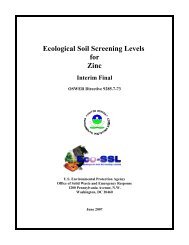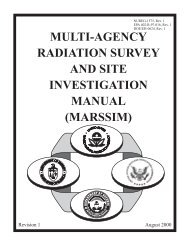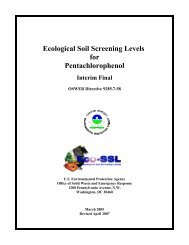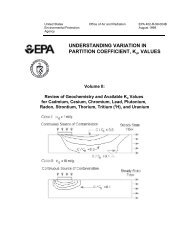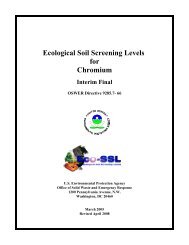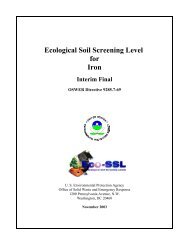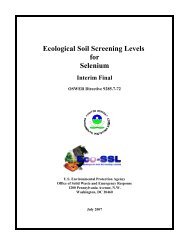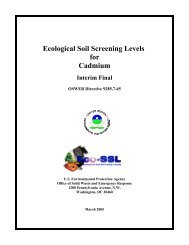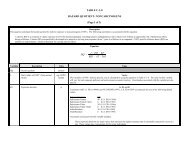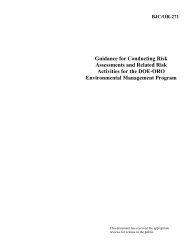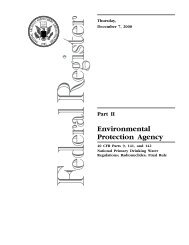Nickel - The Risk Assessment Information System
Nickel - The Risk Assessment Information System
Nickel - The Risk Assessment Information System
You also want an ePaper? Increase the reach of your titles
YUMPU automatically turns print PDFs into web optimized ePapers that Google loves.
4.0 ECO-SSL FOR SOIL INVERTEBRATES<br />
Of the papers identified from the literature search process, 46 papers were selected for acquisition<br />
for further review. Of those papers acquired, 9 met all 11 Study Acceptance Criteria (U.S. EPA<br />
2003; Attachment 3-1). Each of these papers were reviewed and the studies were scored<br />
according to the Eco-SSL guidance (U.S. EPA, 2003; Attachment 3-2). Twelve studies received<br />
an Evaluation Score greater than ten. <strong>The</strong>se studies are listed in Table 4.1. <strong>The</strong> studies in Table<br />
4.1 are sorted by bioavailability score. <strong>The</strong>re are five studies eligible for Eco-SSL derivation.<br />
<strong>The</strong> Eco-SSL is the geometric mean of the maximum acceptable toxicant concentrations<br />
(MATCs) for five species under different test conditions (pH and % organic matter (OM)) and is<br />
equal to 280 mg/kg dw.<br />
5.0 ECO-SSL FOR AVIAN WILDLIFE<br />
<strong>The</strong> derivation of the Eco-SSL for avian wildlife was completed as two parts. First, the toxicity<br />
reference value (TRV) was derived according to the Eco-SSL guidance (U.S. EPA, 2003;<br />
Attachment 4-5). Second, the Eco-SSL (soil concentration) was back-calculated for each<br />
surrogate species representing different trophic levels based on the wildlife exposure model and<br />
the TRV (U.S. EPA, 2003).<br />
5.1 Avian TRV<br />
<strong>The</strong> literature search completed according to the Eco-SSL guidance (U.S. EPA, 2003; Attachment<br />
4-1) identified 1,169 papers with possible toxicity data for either avian or mammalian species.<br />
Of these studies, 1,101 were rejected for use as described in Section 7.5. Of the remaining<br />
studies, 11 contained data for avian test species. <strong>The</strong>se papers were reviewed and the data were<br />
extracted and scored according to the Eco-SSL guidance (U.S. EPA, 2003; Attachment 4-3 and 4-<br />
4). <strong>The</strong> results of the data extraction and review are provided as Table 5.1. <strong>The</strong> complete results<br />
are included as Appendix 5-1.<br />
Within the reviewed papers, there are 28 results for biochemical (BIO), behavior (BEH),<br />
physiology (PHY), pathology (PTH), reproduction (REP), growth (GRO), and survival (MOR)<br />
effects that meet the Data Evaluation Score of >65 for use to derive the TRV (U.S. EPA, 2003;<br />
Attachment 4-4). <strong>The</strong>se data are plotted in Figure 5.1 and correspond directly with the data<br />
presented in Table 5.1. <strong>The</strong> no-observed adverse effect level (NOAEL) results for growth and<br />
reproduction are used to calculate a geometric mean. This result is examined in relationship to<br />
the lowest bounded lowest-observed adverse effect level (LOAEL) for reproduction, growth, and<br />
survival to derive the TRV according to procedures in the Eco-SSL guidance (U.S. EPA, 2003);<br />
Attachment 4-5).<br />
A geometric mean of the NOAEL values for reproduction and growth was calculated at 6.71 mg<br />
nickel/kg bw/day. This value is lower than the lowest bounded LOAEL for reproduction, growth,<br />
or survival. <strong>The</strong>refore, the TRV is equal to the geometric mean of the NOAEL values for<br />
reproduction and growth and is equal to 6.71 mg nickel/kg bw/day.<br />
Eco-SSL for <strong>Nickel</strong> 6<br />
March 2007



